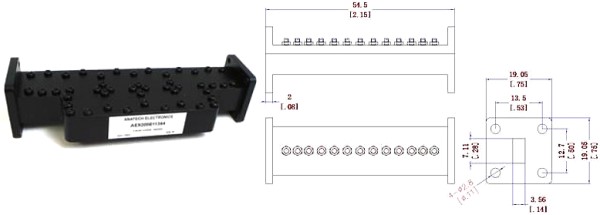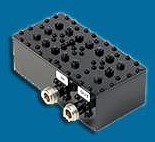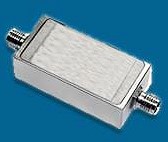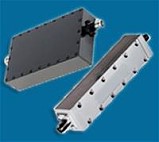
Press Release Archives:
2025 |
2024 |
2023 |
2022 |
2021
2020 |
2019
Content is copyright of company represented. Page format, custom text and
images are RF Cafe copyright - do not distribute. Note: Beginning
March 2025, posting of press releases will cost $100 each for non-advertisers.

Anatech Electronics, an RF and microwave filter company, has introduced a new
line of suspended stripline and waveguide type RF filters. Sam Benzacar wrote as
part of Anatech's July newsletter about the need for and emergence of fully
integrated millimeter-wave transmitters and receivers for the 5G smartphone
market. It is worth noting that the phrase "5G smartphone market" is not
redundant since 5G is intended to go well beyond just phones. Vehicle-to-vehicle
communications and factory automation are just two of the many other
applications planned and currently being implemented. Also included are a few news headlines related to Anatech's core business
of designing and manufacturing filters.
A Word from Sam Benzacar
 Device For
the Future : Part One
By Sam Benzacar
In my conversations with customers, members of the industry, and in the course
of traversing the Web I sometimes come across a technological development that really
stands out. One of the most impressive has immense potential for 5G and is indicative
of what will be required to effectively integrate millimeter-wave bands in a smartphone.
The product I'm referring to is the QTM052 RF system on chip (RFSoC) revealed by
Qualcomm back in 2017 and has since revised and reduced in size by 25%.
Although its largest target market is end-user devices and small cell base stations,
Verizon is using it in the company's 28-GHz fixed wireless access systems, and AT&T
has committed to using it as well. As you can see from the photo, the device is
very small, measuring 18 x 5-mm, but inside are a complete 5G NR transceiver including
front-end components and RF power amplifier, power management IC, and an entire
24-element phased-array antenna. Equally amazing is that it operates between 26.5
to 29.5 GHz, 27.5 to 28.35, and anywhere within 37 and 40 GHz as well, with total
available bandwidth of 800 MHz. The module supports up to 2x2 MIMO with dual polarization
in both the downlink and the uplink.
 Put four of these
in the corners of a smartphone and when combined with the company's Snapdragon X50
modem, they can perform beamforming, steering, and tracking, and route signals to
each module based on signal and environmental conditions. It helps solve the most
significant issue with using millimeter-wave frequencies in a hand-held mobile device:
propagating signals in and out when it's in your hand, moving around at various
angles, or in your pocket or pocketbook. Put four of these
in the corners of a smartphone and when combined with the company's Snapdragon X50
modem, they can perform beamforming, steering, and tracking, and route signals to
each module based on signal and environmental conditions. It helps solve the most
significant issue with using millimeter-wave frequencies in a hand-held mobile device:
propagating signals in and out when it's in your hand, moving around at various
angles, or in your pocket or pocketbook.
The patch and dipole antennas provide spherical coverage in each polarization
and beam steering of +/-45 deg. The power amplifier can deliver 10 to 15 dBm output
power at 28 GHz, although it typically operates backed off to 6 to 8 dBm. An EIRP
up to 35 dBm can be achieved thanks to the 5 dBi gain of a half-wave patch antenna,
but the 2x2 array provides another 6 dB of summation gain and 6 dB beamforming gain.
Using only one polarization, 3 dB gain can be achieved for a total of 20 dB. One
module has typical DC power dissipation with four transmit channels in operation
of 380 mW or less.
This device is probably not the only one because others may be lurking within
the confines of other semiconductor companies and phone manufacturers (Huawei comes
to mind). But so far it appears only Qualcomm has publicly announced such a device
with a reasonable amount of information.
I am very sure that in the advent of 5G many other devices will be popping out
of the woodwork; an interesting journey. Stay tuned.
 Wireless Traffic, Investment Growing Fast Wireless Traffic, Investment Growing Fast
Americans used an amazing 28% more mobile data in 2018 than the year before,
28.58 trillion megabytes, according to the CTIA's 2019 Annual Wireless Industry
Survey. There were 21.5 million more devices (for a total of 421.7 million) connected
to mobile networks last year. Half were smartphones but data-only products such
as watches, IoT devices, and connected cars represent the major growth areas. In
addition, wireless carriers spent $27.4 billion on infrastructure and related CAPEX,
$1.8 billion more than in 2017. There are now about 394,000 5G-capable cell sites
in operation.
TV White Spaces: Theaters Cry Foul
 As Microsoft
pushes its proposal at the FCC for using the so-called TV white spaces to expand
Internet access to rural areas, various music industry organizations and microphone
manufacturers such as Shure are cautioning that use of these frequencies could interfere
with wireless microphones. Microsoft's plan covers only licensed wireless mics,
not unlicensed ones of which there are huge number. While the organizations all
say they strongly in support of Microsoft's overall goal, they want assurance that
if the plan is implemented, all wireless mics will be protected from interference. As Microsoft
pushes its proposal at the FCC for using the so-called TV white spaces to expand
Internet access to rural areas, various music industry organizations and microphone
manufacturers such as Shure are cautioning that use of these frequencies could interfere
with wireless microphones. Microsoft's plan covers only licensed wireless mics,
not unlicensed ones of which there are huge number. While the organizations all
say they strongly in support of Microsoft's overall goal, they want assurance that
if the plan is implemented, all wireless mics will be protected from interference.
Air Force Develops Microwave Drone Killer
 Researchers from the Air Force Research Laboratory
at Kirtland Air Force Base have created a microwave weapon capable of taking out
drones called the Tactical High-Power Microwave Operational Responder (THOR). It
reportedly costs about $10 million apiece, can down up to 50 drones simultaneously.
The platform is mobile and can be deployed in less than 3 hours by connecting its
three parts, after which it can be operated remotely from a laptop, positioning
its antenna quickly over a 360-deg. range. The Air Force recently stated that multiple-drone
attacks are a priority for its directed-energy weapons system development efforts,
which includes both microwave laser systems. Researchers from the Air Force Research Laboratory
at Kirtland Air Force Base have created a microwave weapon capable of taking out
drones called the Tactical High-Power Microwave Operational Responder (THOR). It
reportedly costs about $10 million apiece, can down up to 50 drones simultaneously.
The platform is mobile and can be deployed in less than 3 hours by connecting its
three parts, after which it can be operated remotely from a laptop, positioning
its antenna quickly over a 360-deg. range. The Air Force recently stated that multiple-drone
attacks are a priority for its directed-energy weapons system development efforts,
which includes both microwave laser systems.
 Ford Showed Its
C-V2X Ford Showed Its
C-V2X
Ford showed off its cellular vehicle-to-everything (C-V2X) technology at the
recent meeting of the Intelligent Transportation Society of America, including a
roadside module that lets vehicles communicate with pedestrians and bicyclists.
Called an interpreter, the device uses cellular, Bluetooth and other short-range
solutions to notify pedestrians of oncoming vehicles via their smartphones. The
company also demonstrated a system that intelligently makes decisions concerning
right-of-way at intersections by establishes a “discussion” between vehicles.
Getting Ready for 5G:
Anatech Electronics introduce New Ka band 30.5 GHz Waveguide Band Pass Filter.
Featuring a center frequency of 30.5 GHz, a bandwidth of 1000 MHz, an Insertion
Loss 1 dB Max, and a Power Handling is 20 watts.

Anatech Electronics Introduces a New Line of Suspended Stripline and
Waveguide Type RF Filters
Check out Our Filter Products



Cavity Band Pass Filters
LC Band Pass Filters Cavity Bandstop/Notch Filter
About Anatech Electronics
Anatech Electronics, Inc. (AEI) specializes in the design and manufacture of
standard and custom RF and microwave filters and other passive components and subsystems
employed in commercial, industrial, and aerospace and applications. Products are
available from an operating frequency range of 10 kHz to 30 GHz and include cavity,
ceramic, crystal, LC, and surface acoustic wave (SAW), as well as power combiners/dividers,
duplexers and diplexers, directional couplers, terminations, attenuators, circulators,
EMI filters, and lightning arrestors. The company's custom products and capabilities
are available at www.anatechelectronics.com.
Contact:
Anatech Electronics, Inc. 70 Outwater Lane Garfield, NJ 07026 (973)
772-4242
sales@anatechelectronics.com
Posted July 10, 2019
|











 Put four of these
in the corners of a smartphone and when combined with the company's Snapdragon X50
modem, they can perform beamforming, steering, and tracking, and route signals to
each module based on signal and environmental conditions. It helps solve the most
significant issue with using millimeter-wave frequencies in a hand-held mobile device:
propagating signals in and out when it's in your hand, moving around at various
angles, or in your pocket or pocketbook.
Put four of these
in the corners of a smartphone and when combined with the company's Snapdragon X50
modem, they can perform beamforming, steering, and tracking, and route signals to
each module based on signal and environmental conditions. It helps solve the most
significant issue with using millimeter-wave frequencies in a hand-held mobile device:
propagating signals in and out when it's in your hand, moving around at various
angles, or in your pocket or pocketbook.  Wireless Traffic, Investment Growing Fast
Wireless Traffic, Investment Growing Fast As Microsoft
pushes its proposal at the FCC for using the so-called TV white spaces to expand
Internet access to rural areas, various music industry organizations and microphone
manufacturers such as Shure are cautioning that use of these frequencies could interfere
with wireless microphones. Microsoft's plan covers only licensed wireless mics,
not unlicensed ones of which there are huge number. While the organizations all
say they strongly in support of Microsoft's overall goal, they want assurance that
if the plan is implemented, all wireless mics will be protected from interference.
As Microsoft
pushes its proposal at the FCC for using the so-called TV white spaces to expand
Internet access to rural areas, various music industry organizations and microphone
manufacturers such as Shure are cautioning that use of these frequencies could interfere
with wireless microphones. Microsoft's plan covers only licensed wireless mics,
not unlicensed ones of which there are huge number. While the organizations all
say they strongly in support of Microsoft's overall goal, they want assurance that
if the plan is implemented, all wireless mics will be protected from interference.
 Researchers from the Air Force Research Laboratory
at Kirtland Air Force Base have created a microwave weapon capable of taking out
drones called the Tactical High-Power Microwave Operational Responder (THOR). It
reportedly costs about $10 million apiece, can down up to 50 drones simultaneously.
The platform is mobile and can be deployed in less than 3 hours by connecting its
three parts, after which it can be operated remotely from a laptop, positioning
its antenna quickly over a 360-deg. range. The Air Force recently stated that multiple-drone
attacks are a priority for its directed-energy weapons system development efforts,
which includes both microwave laser systems.
Researchers from the Air Force Research Laboratory
at Kirtland Air Force Base have created a microwave weapon capable of taking out
drones called the Tactical High-Power Microwave Operational Responder (THOR). It
reportedly costs about $10 million apiece, can down up to 50 drones simultaneously.
The platform is mobile and can be deployed in less than 3 hours by connecting its
three parts, after which it can be operated remotely from a laptop, positioning
its antenna quickly over a 360-deg. range. The Air Force recently stated that multiple-drone
attacks are a priority for its directed-energy weapons system development efforts,
which includes both microwave laser systems.  Ford Showed Its
C-V2X
Ford Showed Its
C-V2X 





